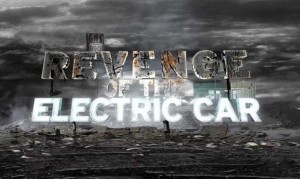It’s not quite a mea culpa. Anything but. When filmmaker Chris Paine’s earlier documentary hit the screens five years ago it served to focus his outrage that the era of the electric car had come and gone. But as Paine’s latest film reveals reports of the death of the battery-electric vehicle were greatly exaggerated.
The 2006 documentary, “Who Killed the Electric Car?” pointed plenty of fingers, mostly at General Motors for pulling the plug on its original EV1 battery car. With the release of “Revenge of the Electric Car,” which opens today, Paine is once again pointing his hectoring lens. But this time he has plenty of positive things to say – notably about GM.
It’s clear things have changed since the original film came out. “Who Killed…” was written in the wake of California’s decision to abandon a noble but flawed experiment aimed at forcing manufacturers to create a new generation of so-called zero-emissions vehicles. With no other technology even close to ready for market that meant battery cars like the EV1.
But even those weren’t exactly ready for prime time, most using primitive lead-acid or only slightly advanced nickel-cadmium and nickel-metal hydride batteries that provided minimal range and performance. When it was clear the mass market was ready to walk rather than plug into the new offerings California regulators admitted defeat and effectively abandoned the mandate.
But a small portion of the Golden State’s more environmentally conscious population wanted to hear nothing of that setback. In fact, when GM announced it was calling in the leases on the EV1 there were protests and loud howls of agony, Paine protesting with his camera. Never mind that GM was actually the last of the major makers to walk away from the nascent EV market, it was an easy villain with a history of being less than eco-friendly.
These days, the post-bankruptcy GM is struggling hard to reposition itself and create an aura of environmental consciousness – having seen what that can do for arch-rival Toyota and its Prius hybrid, the unofficial California mascot. (The Chevy Volt reflects a new attitude at GM, opines TheDetroitBureau.com. Click Here for that column.)
The Chevrolet Volt, albeit struggling to find a market, is the new toy for green-minded buyers, and Paine pays respects to a company he not long ago challenged. He also has plenty of positive things to say about the other makers getting into the battery car game, like Nissan, which has taken an equally risky move to try mass marketing the pure battery-electric Leaf.
Will a third film be called for? It’s difficult to say, and one could only guess what it might be titled in 2016. If the market truly buys into the technology it might be dubbed, “See, I Told You So.” On the other hand, if Volt and Leaf sales – as well as demand for the upcoming Prius Plug-In, Ford C-Max Energi, Tesla Model S and others – don’t gain momentum, Paine might have to return to his earlier theme with, “There They Go Again.”
What’s clear is that the filmmaker is largely talking to a selected audience who shares his belief that batteries can change the world – or at least the roadway. Whether there are enough like-minded motorists to make the latest film a success – and to make a business case for electric vehicles – remains to be seen.

